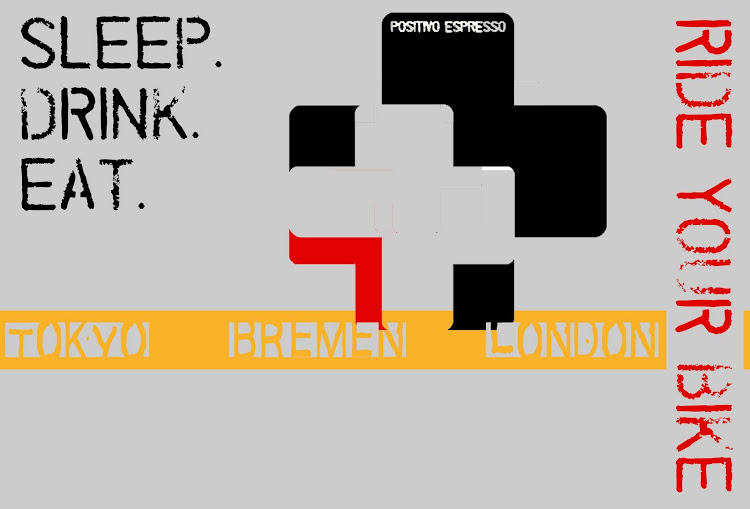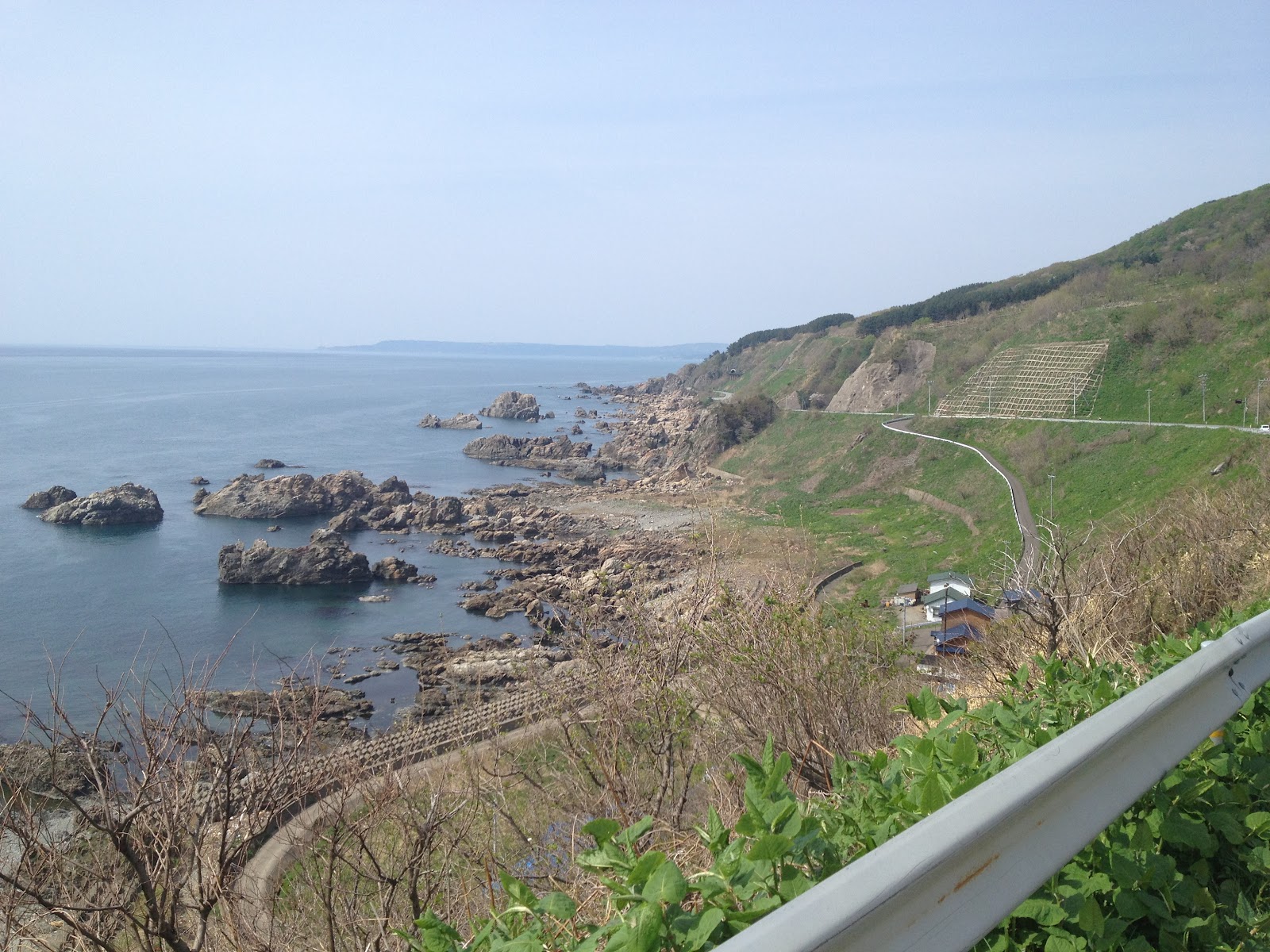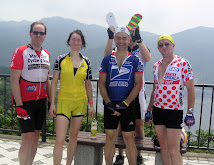One of the topics that long-distance and Audax/Brevet riders tend to get a bit obsessive about is bicycle lighting. They (we) also tend to obsess over products that make us self-reliant when we ride. So my apologies for this somewhat geeky and long post.
Last summer at Paris Brest Paris, I noticed that many, perhaps a majority of the participants from some countries seemed to be using lights powered by dynamo hubs.
Of course, I knew what a dynamo hub was -- you see them on practically half of the shopping bikes (mama chari) in Japan. My wife's shopping bike has one. But I had always assumed that they produced too much drag to be used for longer distance riding, even where you need lights for many hours at night, several nights in a row. (And this is certainly what I heard from Japanese mechanics and cycle shop owners -- too much drag!). I was wrong -- as several of the PBP riders were happy to explain. Top dynamo hubs in recent years create so little drag as to be insignificant in any context except racing, and they save weight, trouble and cost when compared to carrying and using multiple sets of spare batteries. This was of special interest to me at the end of PBP. Before, I had been quite happy with a couple of small, cheap, bright Gentos LED lights, just swapping in spare batteries or buying more at a convenience store when I ran low during night rides. But as I found myself rationing batteries on the last night of PBP so that I would have light available until morning, and then
crashed out after blowing both tires on a small barrier in the roadway that I had not seen, I thought maybe I should try a dynamo hub.
So when I got back home to Tokyo in August, I did some basic reading on the Internet about them. I learned that the "Campy Record" of dynamo hubs is the
Schmidt nabendynamo out of Germany (SON Delux and SON 28). They are very nice to look at (polished silver), fairly light weight -- especially the SON Delux -- very low drag with or without the light turned on, but costly, and expensive. Did I mention that they also have a high price ... In Japan, the price borders on outrageous. In Germany, it is just high, not outrageous.
So I
read some comparative reviews which persuaded me that the newest DH-3N80 Shimano dynamo hub, with "Ultegra class bearings" would be a good compromise -- not quite as low drag, especially with the light off, but lacking the vibration at certain speed ranges that some people complain about with Schmidt hubs, and a bit heavier. Maybe 35-40% of the Schmidt's cost at retail. The DH-3N80 is, well, the "Shimano" of dynamo hubs -- not a thing of beauty, certainly not something you can get passionate about, but functional and not temperamental. I built up
Wheel No. 00001 around one of these. Shimano hubs are readily available in Japan, of course, and it works just fine.
In my online research, I found another interesting approach -- a hub with a mechanical switch to completely disengage and separate the magnets, thereby eliminating any extra drag whatsoever as compared to a non-dynamo hub while a light is off and the magnets are disengaged. This version, sold in Germany by Supernova, which also makes the beautiful, expensive E3 Pro lights, seemed worth further study. I noticed that the Supernova detachable hub seemed the same as one made by a small company in Taiwan, SP Dynamo (Series 7). It was pretty clear that
SP Dynamo must be the source of the Supernova product. Likewise, the Velo Orange brand in the U.S. seemed to be selling a similar design of hub, in a Velo Orange package.
I sent a note to SP Dynamo and was delighted to get back a personal reply from the main man there, Vic Chen. He noted that for long distance night riding, such as Audax events, I might prefer their Series 8 hubs. The Series 7 detachable hub adds a lot of weight, and the "light off" drag of the Series 8 hub is so low as to be inconsequential and make it a better choice, especially for rides with lots of elevation gain. The PV-8 is their standard model designed for a 622/700C road bike wheel. But Vic mentioned that if you are a Brevet rider using an LED light, and want the best combination of low drag, it should be possible to use their SV-8, which is designed for 20" wheels. This light might not generate sufficient current to power many lights when ridden at very slow, grandma's shopping bike speeds, or if you want to run a USB charger at the same time as the light. But otherwise it is great. Also, he noted, you are trying to minimize "light on" drag, you need to choose a light that does not draw too much an electric load -- such as some super bright trail-riding versions.
(The "V" in "PV-8" and "SV-8" is the version to be used with a rim brake. They also make a "D" version of each model (PD-8 and SD-8), for use with a disk brake. The shape of the actual shell around the dynamo's magnets and wiring is the same for both "V" and "D" models, with the flanges are somewhat closer to the center of the bike than on many road front hubs. This creates a slightly more aerodynamic wheel, but slightly less wide support for the rim -- and is similar to the SON Delux.)
 |
| SV-8 in silver or black; PV-8 looks identical |
The PV-8 is SP Dynamo's model designed for a standard 700C road wheel. It is actually available in Japan (via Trisports, and maybe one other wholesaler), at least in black, and costs about the same as the Shimano DH-3N80. I could not find the SV-8 in Japan, but eventually purchased one direct from Vic. The PV-8 went on Wheel No. 00004 -- which I rode a few times just to check it and then sent to a friend whose bike with dynamo hubbed front wheel had been stolen.
The silver SV-8 went on Wheel No. 00005, which I kept and have now used for around 2000 kms -- the biggest test being 1375 kms of Tohoku riding over Golden Week -- including one day with lots of rain and plenty of water on the road -- plus lots of other trips around and near town. It should get another real test when I use it on the Cascade 1200 in late June. I like the look of the silver version. Not quite the shiny polished silver of the Schmidt, but very nice.
A
recent independent German test of various hubs by an online magazine vindicates SP Dynamo's claim to be very comparable to the Schmidt hubs in terms of performance. (NOTE: Actually, the author of this article is identified as working for the manufacturer of SON hubs, Schmidt Machinenbau) It tests the PV-8, not the SV-8 -- which of course is lighter weight and lower drag than the PV-8, but not approved in Germany for use with 700mm road bike wheels. (If you use Google Chrome browser and have your browser translate the German article to English, you can decipher 95%+ of the article.) The test also includes the Shimano DH-3N80, which does okay, except it seems to have much higher "light off" drag than either Schmidt or SP Dynamo, because of different placement of its magnets. And there is another new Shimano hub in the test -- 1.5V instead of 3V, for an upcoming new standard.
Here is another German site that has some reviews and relevant information, including some English content at the far lower left.
The German test only covers the PV-8. If the SP Dynamo PV-8 has very similar low drag to the Schmidt models, it excels in two other areas -- lower weight and lower price. If you compare the PV-8 to the new SON28, it is 390g vs 440g. If you compare the SV-8 to the SON Delux, it is 367g vs 390g. (Since the SON Delux is also a lower output model, this seems appropriate, whereas the German test compared the PV-8 to the SON Delux, both 390g. And did I mention that the SP Dynamos retail for much less than half of what the Schmidt ones do?
Charts on SP Dynamo's website compare the SV-8/SD-8 with a "Germany Brand" dynamo. It shows the output (voltage) and drag (light on and light off) of the S-8 dynamo using a 20" wheel at various speeds. I believe the comparison is against the SON Delux (also in theory a 20" wheel model, though approved in Germany for 700mm wheels with the SON Edelux LED light).
A second chart that compares the higher output, slightly higher drag/weight P[V/D]-8 against a "Japanese Brand" dynamo using a 700C wheel. This shows the weak point of the Shimano DH-3N80 -- extra drag with the light off. Maybe not enough for most of us to notice, but still it is 2.5 times the drag of the P-8.
In any event, I now have enough experience with the SV-8 so that I feel comfortable giving a very positive review. It works like a charm, produces plenty of current to power either my Philips Saferide LED 60 Lux light or my Supernova E3 Pro LED. And it is very low drag -- a simple "spin test" confirms what the more scientific test data shows.
Using the SV-8 with Supernova light in Tohoku, at the very slowest (almost crawling) night climbing speed, I still would get a reasonable light from the SV-8. When I stood out of the saddle and basically was "walking" up the hill at 5 kph, the light would brighten and dim with each stomp of the pedals (dimming down almost to the "stand light" level). But I do not need a very bright light when going at 5 kph. And when I got back in the saddle and pedaled with a bit more of a normal rotation, even at very slow speed, the light was steady. On the flats and on fast descents, the light stretched way out ahead down the road, giving ample advance warning of any danger.
Only time will tell how durable the hub is -- whether the seals keep water out over the long haul, whether the sealed bearings will hold up or will need to be replaced. But so far, so good, including plenty of riding in rain and with standing water on the road.
At a more wonky level, by looking at the first chart above, showing the S-8 voltage and drag at various speeds with a 20" wheel, it is possible to roughly extrapolate to the result with a 700C wheel if we assume that the circumference of the 20" wheel and tire is about 0.75 times that of the 700C wheel and tire -- of course, the actual ratio will depend on the tires used, and whether you are using a 406C or 451C version of the 20" wheel. The difference could be greater. I'm no electrical engineer, and I'm just eyeballing the test charts on the SP Dynamo page, but based on the German independent test I feel comfortable at least suggesting as follows -- please let me know if you disagree.
1. Sufficient Voltage
If the S-8 is placed on a standard 700C road
bike wheel, its voltage at any given
speed as shown on the S-8 Chart will need to be determined by looking at 0.75
times the speed shown on the Chart. For voltage produced by an S-8 at 20 kph using a 700c wheel, look at the
15 kph on the chart. Likewise, for
voltage at 30 kph, look at 22.5 kph on the chart. As can be seen, using a 700C wheel, 6V is
obtained at approximately 17.5 kph. With a road bike wheel, 4V can be obtained at
approximately 9 kph -- my speed for steep, slow, climbing at a 9-10% grade. 3-4V is plenty to power
most dynamo LED lights.
2. Lowest Drag - Light On
Conversely, the charts showing "additional power
input" needed when the light is on or off must be adjusted downward if the S-8 is used with a 700C wheel. The S-8 chart shows that at a speed of 15 kph,
with the light ON, power input of approximately 4.8 watts is taken. In fact, however, at 15 kph the
additional wattage should be only that shown as needed to run at 11.25 kph, approximately 4.0 watts.
Similarly for the S-8 at 20 kph with the light ON and 700c
wheels, required wattage is approximately 4.8
watts, as opposed to 5.25
watts if using 20" wheels
with the SV-8, or 5.5 watts
if using the PV-8, 5.1 watts
if using the Schmidt dynamo (adjusted for 700C wheel size), or 6.4 watts if using the Shimano
model.
3. Lowest Drag - Light Off
For the S-8 at 20 kph with the light OFF and 700c wheels,
required wattage is approximately 0.5
watts, as opposed to 0.65 watts if using 20" wheels
with the SV-8, or 0.6 watts if using
the PV-8, 0.65 watts if using the
Schmidt (adjusted for 700C wheel size), or 1.5 watts if using the Japan brand (must be Shimano) model.
At 30 kph with the light OFF and 700C wheels,
required wattage for the SV-8 is approximately 0.7
watts, as opposed to 0.9
watts if using 20" wheels with the SV-8, or 1.0 watts if using the PV-8, 0.95
watts if using the Schmidt, or 2.3
watts if using the Shimano model.
4. Lowest Weight
Weight of the SV-8 with 100mm spacing for a road bike fork
is 367 grams. PV-8 is 390
grams. Schmidt SONdelux is 390 grams, newest SON28 is 440 grams (down significantly from 570
grams in 2011 and earlier models), Shimano DH-3N80 is approximately 520 grams.
5. Lower Price
If I forgot to mention it, SV-8 retail cost is much less than 50% of the price of Schmidt models, and is comparable with the Shimano DH-3N80.
6. Conclusion
The SV-8 provides ample output for an LED light and affords
the lightest weight, lowest drag solution, with light on or off, at a lower cost.
Given the benefits of having a dynamo -- not just for lighting, but also with special adapter, for charging USB devices such as Garmin Edge GPS computers and smartphones -- there is no excuse not to have one for any ride that is going to extend over several days or require more than a few hours of light.
I have yet to explore the add-ons needed for USB charging from a dynamo hub ... but you can find some information at
the relevant thread on the TCC BBS, and that is on my future agenda.
Now that I've gotten confident in my wheelbuilding skills, I am thinking of ordering some more of these direct from the manufacturer to build wheels for friends and family. If anyone is interested in having a wheel built with an SP Dynamo SV-8 or PV-8, just let me know.
UPDATE (July 6 2012):
A new "spin test" comparison of the SV-8 against the SON XS -- these are both 74mm versions for use with Brompton or similar folding bike wheels ... but the hub internals should not differ from other models. Here is a
LIGHT ON spin test. And here is a
spin test with the LIGHT OFF. And the winner is ???
UPDATE (July 30 2012):
The SV-8 has now made it through (1) 1375 kms in Tohoku in May, (2) the Cascade 1200, and (3) the Rocky Mountain 1200, and still seems as good as new. Each of these rides involved at least 24 hours of nasty weather -- riding in sometimes heavy rain, with water collecting on the road surface, and the Rocky Mountain 1200, in particular, was very, very tough on my equipment -- shredded tire sidewalls, broken spoke, broken shifter cable, lots of flats, and on and on.
UPDATE (March 2013): I have added a
review of some different LED lights, in case of interest.
UPDATE (April 2014): The SP dynamo hubs I am using are all working beautifully. The "main" SV-8 on the A23 front wheel I use for most brevets and randonees now has over 15000 kms at least. I stopped counting. The disk brake version on my
Yamabushi has thousands of kms, including urban riding as my commuter bike, as well.
And no reports of any problems from the people I have given these to or built up wheels for. Let me know if you do have any issues.
SV-9 UPDATE (December 2014): I now have gotten my hands on one of the new series 9 SP Dynamos, the SV-9. This hub is over 15% lighter weight than the SV-8, and noticeably more compact, and noticeably smoother than any other dynamo hub I have seen or tried, especially when an attached light is switched off.
See my review here. Watch for it as it becomes available over coming months.













































